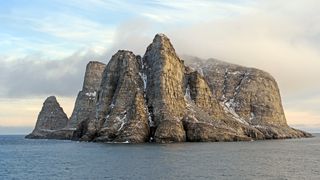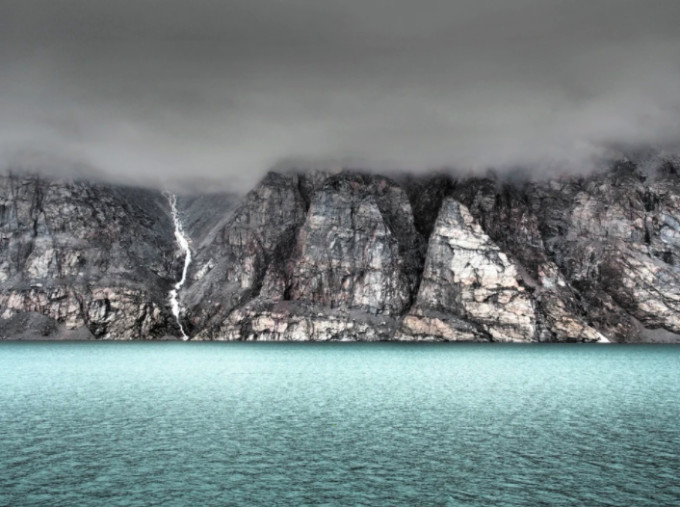Piece of lost continent discovered beneath Canada

Scientists found an ancient continent's chemical fingerprints in rock samples taken from Baffin Island in Nunavut, Canada.
A piece of a lost continent has been discovered lurking beneath Canada — and the evidence was hiding in rocks that originated in Earth's interior, where diamonds form.
The secret was concealed in a type of diamond-bearing volcanic rock, known as kimberlite. Kimberlite originates deep underground in magma in Earth's mantle, and picks up hitchhiking diamonds as it hurtles toward the surface during volcanic eruptions. The kimberlite, from Baffin Island in northern Canada, was collected by a diamond mining and manufacturing company.
Scientists found that the mineral chemistry of the Baffin Island kimberlite matched that from an ancient and long-lost continent that formed nearly 3 billion years ago and broke up 150 million years ago. A portion of that "lost" continent still anchors part of North America, and based on the location of the kimberlite samples, the size of that ancient slab is about 10% bigger than previously thought, researchers reported in a new study.
Related: Shine on: Photos of dazzling mineral specimens"Finding these 'lost' pieces is like finding a missing piece of a puzzle," lead study author Maya Kopylova, a geologist with the University of British Columbia in Canada, said in a statement.
"One fragment of the North Atlantic craton is now part of Scotland," Kopylova told Live Science in an email. Another fragment is part of Greenland, and one more is part of Labrador in eastern Canada.
"Now we have found one more fragment on Baffin Island," she said. For hundreds of millions of years, plate tectonics pushed continents together to form giant supercontinents, only to pull them apart and push them together again. The last of the supercontinents, Pangaea, began to separate about 200 million years ago, and by around 60 million years ago, the continents had split into the seven that we know today: Africa, Antarctica, Asia, Australia, Europe, North America and South America.
Though the planet's first continents fragmented and were lost to time, remnants of the long-lost land masses survive to this day, as stable cores in our modern continents. The kimberlite samples from Baffin Island, which came from a depth of nearly 250 miles (400 kilometers), bore chemical similarities to mantle rock samples from underneath part of the North Atlantic craton in Greenland, according to the study.
Under most remnants of ancient continents, the upper mantle contains about 65% olivine — "the main mineral of the upper mantle" — and about 25% of another mineral called orthopyroxene, Kopylova said. By comparison, the mantle makeup under the North Atlantic craton is about 85% olivine and around 10% orthopyroxene. And the mineral ratio in the Baffin Island kimberlite was a close match to the North Atlantic craton, Kopylova said.
Now, scientists know "with certainty" that part of Baffin Island was at some point joined with the North Atlantic craton, "rather than with other ancient continents," according to KopyloThis is the deepest location where scientists have found a piece of the North Atlantic craton, greatly expanding their view of the first continents from Earth's distant past, the researchers reported.
"Previous reconstructions of the size and location of Earth’s plates have been based on relatively shallow rock samples in the crust, formed at depths of 1 to 10 kilometers [0.6 to 6 miles]," Kopylova said in the email. With these new findings, "our knowledge is literally and symbolically deeper," she added.
Thursday, March 26th 2020, 6:28 pm - Researchers were sifting through samples of igneous rock and diamonds when they made the discovery
Fragments of an ancient lost continent have been discovered underneath Baffin Island in Nunavut.
A team of researchers from the University of British Columbia (UBC) is studying kimberlite that is found in this remote location, which is an igneous rock that forms hundreds of kilometres beneath the Earth’s surface and occasionally contains diamonds. Maya Kopylova, a geologist and professor at UBC, says that many mining companies have a high level of interest in exploring Nunavut and other northern regions of Canada because of the valuable minerals that can be found underneath the Earth’s surface.
The lost continent fragments were discovered when the researchers were analyzing diamond deposits and noticed other unique compositions, which surprisingly indicated that a landmass was previously there. The fragment that was discovered is from the North Atlantic Craton, which is an ancient part of the Earth’s continental crust that ran from Scotland to North America. The craton broke up 150 million years ago and Kopylova says that the discovery adds roughly 10 per cent to the known expanse of the North Atlantic Craton.
 A foggy day at Baffin Bay, Nunavut, Canada. Credit: Jennifer Latuperisa-Andresen/ Unsplash
A foggy day at Baffin Bay, Nunavut, Canada. Credit: Jennifer Latuperisa-Andresen/ Unsplash
Other regions that contain parts of the North Atlantic Craton include Scotland, Greenland and Labrador in Atlantic Canada. The details of this discovery have been outlined in a study that was published in the Journal of Petrology and the researchers say that their discovery will help us learn more about how continents have formed over millions of years.
A vast amount of Earth’s geological history is unknown and scientists are continuously reporting fascinating discoveries. A study that was published in September 2019 revealed that a lost continent was found nearly 1,500 kilometres underneath Europe. Researchers found that a piece of continental crust the size of Greenland separated from North Africa 240 million years ago and plunged into the Earth's mantle underneath Southern Europe. The only part of the continent that remains today is a relatively small section that runs along northern Italy through the most eastern tip of the country and the top few kilometres of the lost continent can still be seen in the mountain ranges.


No comments:
Post a Comment